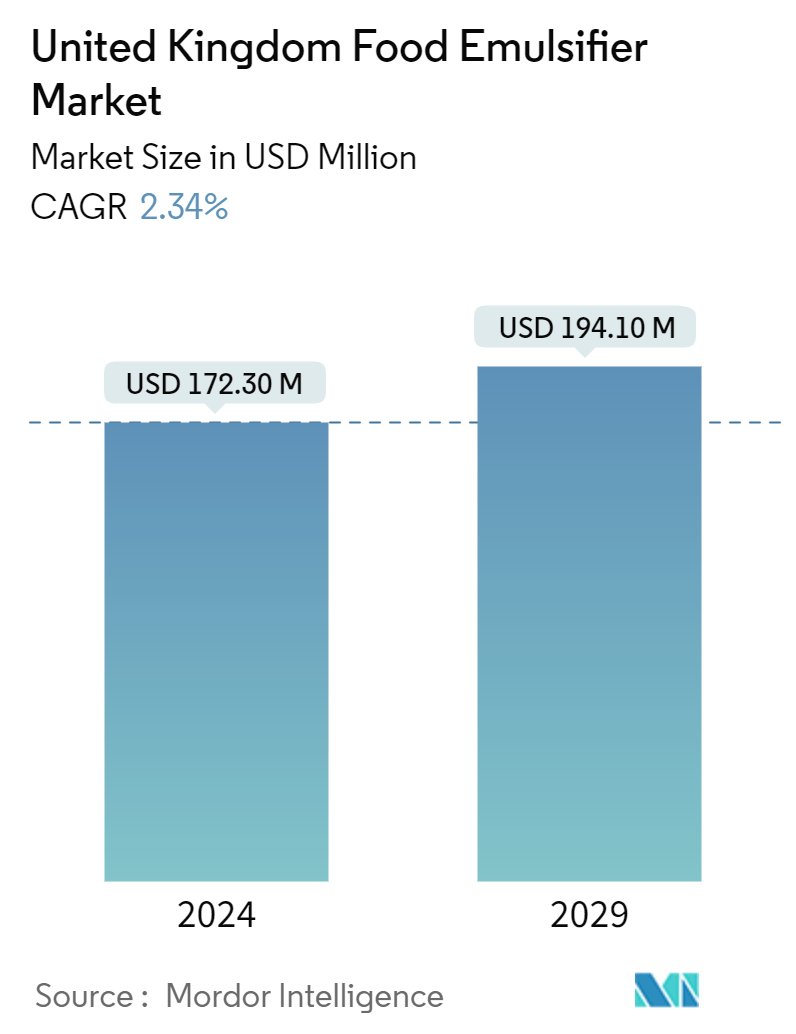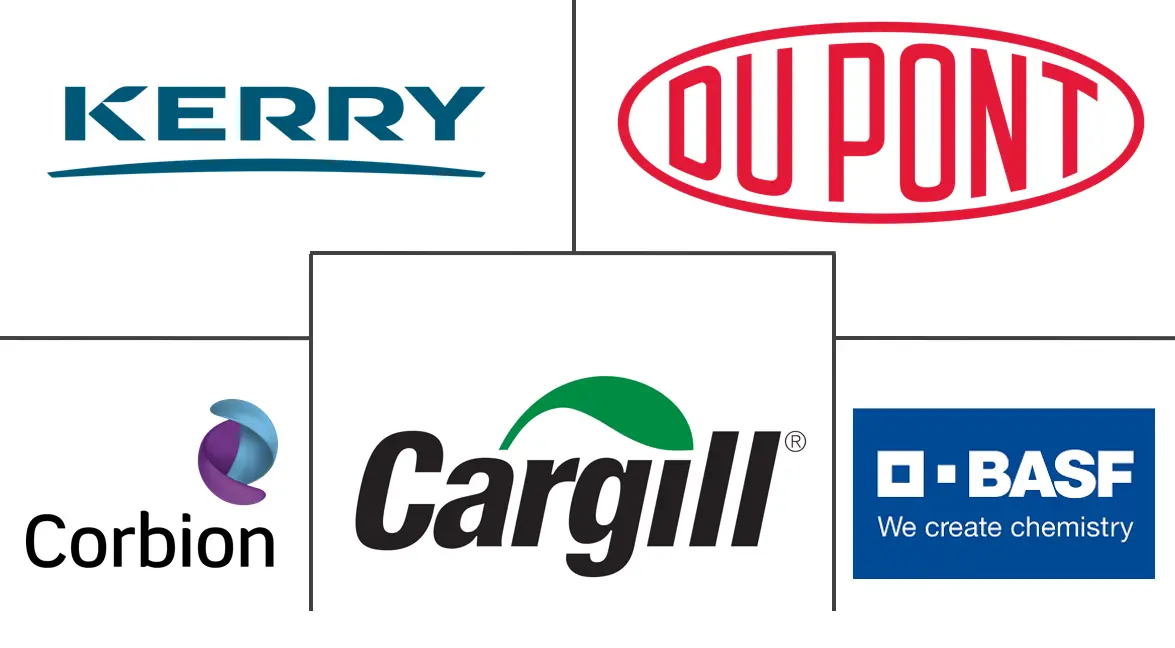Market Size of United Kingdom Food Emulsifier Industry

| Study Period | 2019 - 2029 |
| Base Year For Estimation | 2023 |
| Market Size (2024) | USD 172.30 Million |
| Market Size (2029) | USD 194.10 Million |
| CAGR (2024 - 2029) | 2.34 % |
| Market Concentration | Low |
Major Players
*Disclaimer: Major Players sorted in no particular order |
United Kingdom Food Emulsifier Market Analysis
The United Kingdom Food Emulsifier Market size is estimated at USD 172.30 million in 2024, and is expected to reach USD 194.10 million by 2029, growing at a CAGR of 2.34% during the forecast period (2024-2029).
The dominance of the foodservice industry and rising demand for shelf-stabilized products are driving the market for food emulsifiers in the country. The United Kingdom has a significant market for baked and confectionery goods. The growing number of bakeries in the country has also emerged as one of the major drivers for the emulsifiers market in the United Kingdom. With increased product innovation in the industry, the preference for bakery food products is growing. According to the Federation of Bakeries Limited, over 11 million loaves and packs were sold in the country in 2023.
The population in the country indulges in frequent snacking habits. However, with the rising health trends and awareness, the country’s aging population is looking for healthier alternatives to snacks. This change in consumer behavior demands innovations and advancements in the snacks and confectionery segments, which use emulsifiers as an important ingredient, promising decent consumption in the coming years. Moreover, due to the multifunctional properties of food emulsifiers, there is a growing number of end-use applications. Helping food producers focus and pay particular attention to developing new products with the potential to reduce or limit weight gain is a result of increased consumer awareness regarding healthy eating, which is driving demand for low-fat foods.
United Kingdom Food Emulsifier Industry Segmentation
Food emulsifiers are food additive molecules that stabilize emulsions, preventing liquids that normally do not mix from separating. Emulsifiers create two types of emulsions: either droplets of oil dispersed in water or droplets of water dispersed in oil.
The UK food emulsifiers market is segmented by type into lecithin, monoglyceride, diglyceride, and derivatives, and other types. By application, the market is segmented into dairy and frozen products, bakery, meat, poultry, and seafood, beverage, confectionery, and other applications.
| Type | |
| Lecithin | |
| Monoglyceride, Diglyceride, and Derivatives | |
| Other Types |
| Application | |
| Dairy and Frozen Products | |
| Bakery | |
| Meat, Poultry, and Seafood | |
| Beverages | |
| Confectionery | |
| Other Applications |
United Kingdom Food Emulsifier Market Size Summary
The United Kingdom food emulsifier market is experiencing growth driven by the robust foodservice sector and the increasing demand for shelf-stabilized products. The bakery industry, a significant consumer of food emulsifiers, plays a pivotal role in this market due to its substantial contribution to flour production in the country. As consumer preferences shift towards healthier snacking options, particularly among the aging population, there is a growing need for innovation in the snacks and confectionery sectors. This trend is expected to sustain the demand for emulsifiers, which are crucial in developing these healthier alternatives.
The rise of veganism in the United Kingdom is further influencing the market, with a notable shift towards plant-based emulsifiers like soy lecithin. The demand for organic and sunflower lecithin is increasing, particularly in confectionery applications, due to their natural, safe, and allergen-free properties. The European market, with its high consumption of bread and baked goods, is particularly receptive to innovations in the bakery sector. This has led to a focus on gluten-free products, aligning with consumer interests in healthier dietary options. The market is highly fragmented, with key players such as Cargill, Tate & Lyle, and BASF SA, and is poised for growth, supported by the expanding food and beverage industry, especially in beverages, dairy, and frozen products.
United Kingdom Food Emulsifier Market Size - Table of Contents
-
1. MARKET DYNAMICS
-
1.1 Market Drivers
-
1.2 Market Restraints
-
1.3 Industry Attractiveness - Porter's Five Forces Analysis
-
1.3.1 Threat of New Entrants
-
1.3.2 Bargaining Power of Buyers/Consumers
-
1.3.3 Bargaining Power of Suppliers
-
1.3.4 Threat of Substitute Products
-
1.3.5 Intensity of Competitive Rivalry
-
-
-
2. MARKET SEGMENTATION
-
2.1 Type
-
2.1.1 Lecithin
-
2.1.2 Monoglyceride, Diglyceride, and Derivatives
-
2.1.3 Other Types
-
-
2.2 Application
-
2.2.1 Dairy and Frozen Products
-
2.2.2 Bakery
-
2.2.3 Meat, Poultry, and Seafood
-
2.2.4 Beverages
-
2.2.5 Confectionery
-
2.2.6 Other Applications
-
-
United Kingdom Food Emulsifier Market Size FAQs
How big is the United Kingdom Food Emulsifier Market?
The United Kingdom Food Emulsifier Market size is expected to reach USD 172.30 million in 2024 and grow at a CAGR of 2.34% to reach USD 194.10 million by 2029.
What is the current United Kingdom Food Emulsifier Market size?
In 2024, the United Kingdom Food Emulsifier Market size is expected to reach USD 172.30 million.

